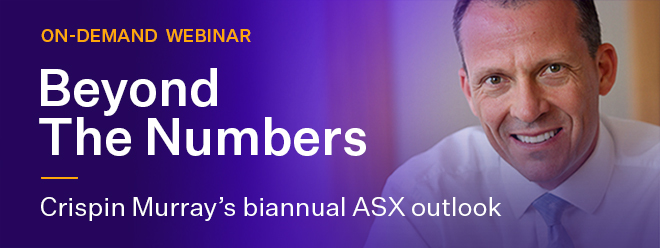
Mainstream Online Web Portal
LoginInvestors can view their accounts online via a secure web portal. After registering, you can access your account balances, periodical statements, tax statements, transaction histories and distribution statements / details.
Advisers will also have access to view their clients’ accounts online via the secure web portal.
Julia Forrest: What’s driving Aussie equities this week
Here are the main factors driving the ASX this week according to Pendal portfolio manager JULIA FORREST. Reported by portfolio specialist Chris Adams.
- Underlying inflation in Australia remained well above the RBA’s target in Q1
- The GDP print in the US suggested ongoing economic strength
- Find out about Pendal Focus Australian Share fund
LAST week was a big one for macro data.
In the US, headline Q1 2024 Gross Domestic Product (GDP) growth came in relatively soft at 1.6%, versus 3.4% in the prior quarter and the 2.5% expected.
At the same time, the Q1 Core Personal Consumption Expenditure (PCE) deflator – a measure of inflation – accelerated to 3.7% annualised, versus 2% in Q4 2023 and the 3.4% expected.
As a result, US bond yields continued their climb, with ten-year Treasury yields ending up five basis points (bps) for the week at 4.67% and the market increasingly implying a first rate cut by the Fed in December.
Chicago Federal Reserve President Austan Goolsbee said that the Federal Open Market Committee needs to “recalibrate” its stance – noting that “progress on inflation has stalled” in 2024 and that after three months, this signal “cannot be dismissed”.
While it was a bumpy week for data, there was an underlying tone of resilience, with the market finding comfort in US Q1 earnings.
The Nasdaq and SP500 ended up by having their best week since November, returning 4.23% and 2.68%, respectively.
AI optimism lifted Alphabet (+10%) across the US$2 trillion market cap threshold, while Nvidia (+6%) and Microsoft (+2%) also gained.
The S&P/ASX 300 was up 0.12%.
The Australian Q1 2024 consumer price index (CPI) came in at 3.6% year-on-year versus the 3.5% expected, slowing from 4.1% in the previous quarter.
The “trimmed mean” measure preferred by the RBA rose 1.0%, again above forecasts of a 0.8% gain.
Following the data release, the Aussie Dollar jumped 0.7% to $0.6530 versus the US Dollar before settling at $0.6517, while yields on the 2-year (up 31bps) and 10-year government bonds (up 27bps) moved higher to trade at 4.18% and 4.52%, respectively.
The two things that the RBA focusses on – employment and inflation – are both above target, with the recent unemployment rate 20bp below the RBA’s forecast (3.9% vs 4.1%) and the trimmed mean inflation now 20bp above (1.01% vs 0.8%).

US macro
Headline GDP growth of 1.6% for the first quarter was softer than the 2.5% expected and the 2.7% forecast by the Atlanta GDPNow measure.
However, the breakdown was quite constructive, as final domestic demand remained solid (up 2.8%) for the quarter – with robust contributions from consumer spending, business fixed investment and residential investment.
The drag came from net exports (down 0.86%), driven by strong import growth apparently related to technology (computers, parts, semiconductors and telecommunications equipment).
In sum, the GDP print suggested ongoing economic strength in the US.
The Atlanta Fed GDPNow estimate for Q2 GDP growth is near 4%, which further fortifies upside risks to the inflation outlook.
The annualised Q1 Core CPI growth of 3.7% was the strongest quarter since the early 1990s, excluding the immediate post-pandemic period.
Core services ex-housing is the key driver, growing at a three-month-on-three-month annualised rate of 5.2%.
This is largely driven in turn by wage growth, where there are some possible early signs of cooling in measures of labour market hiring plans, the quits rate, and the Atlanta Fed wage growth tracker.
However, the US macro backdrop remains strong, with the ISM Manufacturing index showing a big uptick in 2024 and – importantly for markets – earnings fears as reflected in 12-month forward earnings-per-share estimates seeming to have passed.
The combination of sticky inflation and economic resilience raises the question of whether the neutral rate is as low as the Fed and market previously thought and, by extension, whether policy settings are as restrictive as assumed.
Financial conditions are now looser by the Chicago Fed’s own metric than at the beginning of 2022, when rates were effectively at zero and the Fed was still officially saying that inflation was transitory.
The Fed significantly eased financial conditions late last year via its “dovish pivot”, which reduced the global cost of both equity and debt capital.
Fiscal policy is working against the Fed’s rate settings.
The economy is resilient, unemployment is at 3.8% (too low to reduce inflation), and wage growth is strong (albeit slowing).
However, the US fiscal deficit is -6.2% and it is unusual for large deficits in boom times – normally it is the result of recession.
We are a little over six months out from the US Presidential Election and a balanced budget is probably the farthest thing from the mind of either candidate.
As such, the Fed is likely to continue to lean against the continued fiscal dominance.
The problem for the stock market is that rates seem too high to allow equities to push through to higher levels, but not high enough to create the kind of economic slowdown that forces the Fed to ease.
Australia macro
The Q1 3.6% twelve-month growth in Australian CPI slowed from 4.1% in Q4 2023, but by less than the 3.5% expected.
Nearly half of Australia’s CPI basket rose at an annualised rate of more than 3% in the March quarter.
The trimmed mean measure rose 1.0% in Q1, versus the 0.8% seen in Q4 2023 and expected again. The twelve-month rate dropped from 4.2% to 4.0%.
Several components appear to be sticky, notably in domestic market services lifted by rents, insurance and education costs.
Rental prices rose 2.1% for the quarter, in line with low vacancy rates across the capital cities. Rents continue to increase at the fastest rate in 15 years.
On any measure, underlying inflation in Australia remained well above the RBA’s target in Q1.

Adviser Sam is invested
in making our world
A better place.
Watch as Sam meets a
mum rebuilding her life
thanks to responsible
investing
There are some signs that the labour market is beginning to soften, but wage rates remain too high to be consistent with the RBA’s targets.
Monetary policy is working its way through the system, lifting debt service costs and reducing household disposable income.
However, the Stage 3 tax cuts are likely to see an uptick in retail spending from July, with a possible additional $23 billion in spending capacity in FY24/25.
If 75% of this is spent, this could see a 4.1% lift in retail sales.
Europe/UK macro
The Euro area Composite Purchasing Managers’ Index (PMI) came in at 51.4 versus the 50.7 expected, while the Services PMI was at 52.9 versus the 51.8 expected.
The UK Composite PMI was at 54.0 versus the 52.6 expected. Recent data has been solid and picking up, suggesting that economic activity – having initially been shocked by a shift from zero rates – is now adjusting.
US earnings season
With the US market near its most concentrated in history, earnings for the “Magnificent 7” were crucial to markets.
Three of the four that reported were well received (Tesla, Microsoft, Alphabet), with only Meta disappointing – here’s more:
- Alphabet beat expectations for revenue, operating income and EPS. It also announced its first ever dividend and an additional US$70 billion buyback.
- Microsoft beat consensus EPS expectations and highlighted the growth of its cloud computing business and its efforts to bring AI technology to clients.
- Tesla missed on revenue ($21.3 billion versus expectations for $22.3 billion) and earnings estimates for Q1, noting that “vehicle volume growth rate may be notably lower” in 2024 than in 2023. However, investors were upbeat on the company’s strategy going forward, with a focus on “accelerating” the rollout of new, cheaper models. There are some interesting potential parallels between EVs and today’s enthusiasm for AI. Three years ago, EVs – and Tesla in particular – were expected to take over the world. However, competition has been intense in the sector (especially from China) and demand disappointing in some regions.
- Meta saw lighter revenues and higher expenses and capex as it looks to spend more on AI. 2Q24 revenue guidance was below consensus. There is a concern being that advertising revenue is slowing due to geopolitical events.
About Julia Forrest and Pendal Property Securities Fund
Julia Forrest is a portfolio manager with Pendal’s Australian Equities team. Julia has managed Pendal’s property trust portfolios for more than a decade and has 25 years of experience in equities research and advisory, initial public offerings and capital raisings.
Pendal is an Australian investment management business focused on delivering superior investment returns for our clients through active management.
Pendal Property Securities Fund invests mainly in Australian listed property securities including listed property trusts, developers and infrastructure investments.
About Pendal Group
Pendal is an Australian investment management business focused on delivering superior investment returns for our clients through active management.
This information has been prepared by Pendal Fund Services Limited (PFSL) ABN 13 161 249 332, AFSL No 431426 and is current at April 29, 2024.
PFSL is the responsible entity and issuer of units in the Pendal Focus Australian Share Fund (Fund) ARSN: 113 232 812. A product disclosure statement (PDS) is available for the Fund and can be obtained by calling 1300 346 821 or visiting www.pendalgroup.com. The Target Market Determination (TMD) for the Fund is available at www.pendalgroup.com/ddo. You should obtain and consider the PDS and the TMD before deciding whether to acquire, continue to hold or dispose of units in the Fund.
An investment in the Fund or any of the funds referred to in this web page is subject to investment risk, including possible delays in repayment of withdrawal proceeds and loss of income and principal invested.
This information is for general purposes only, should not be considered as a comprehensive statement on any matter and should not be relied upon as such. It has been prepared without taking into account any recipient’s personal objectives, financial situation or needs. Because of this, recipients should, before acting on this information, consider its appropriateness having regard to their individual objectives, financial situation and needs. This information is not to be regarded as a securities recommendation.
The information may contain material provided by third parties, is given in good faith and has been derived from sources believed to be accurate as at its issue date. While such material is published with necessary permission, and while all reasonable care has been taken to ensure that the information is complete and correct, to the maximum extent permitted by law neither PFSL nor any company in the Pendal group accepts any responsibility or liability for the accuracy or completeness of this information.
Performance figures are calculated in accordance with the Financial Services Council (FSC) standards. Performance data (post-fee) assumes reinvestment of distributions and is calculated using exit prices, net of management costs. Performance data (pre-fee) is calculated by adding back management costs to the post-fee performance. Past performance is not a reliable indicator of future performance.
Any projections are predictive only and should not be relied upon when making an investment decision or recommendation. Whilst we have used every effort to ensure that the assumptions on which the projections are based are reasonable, the projections may be based on incorrect assumptions or may not take into account known or unknown risks and uncertainties. The actual results may differ materially from these projections.
For more information, please call Customer Relations on 1300 346 821 8am to 6pm (Sydney time) or visit our website www.pendalgroup.com

